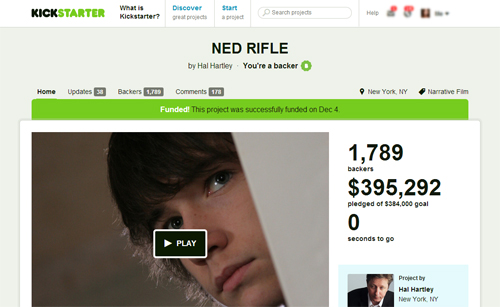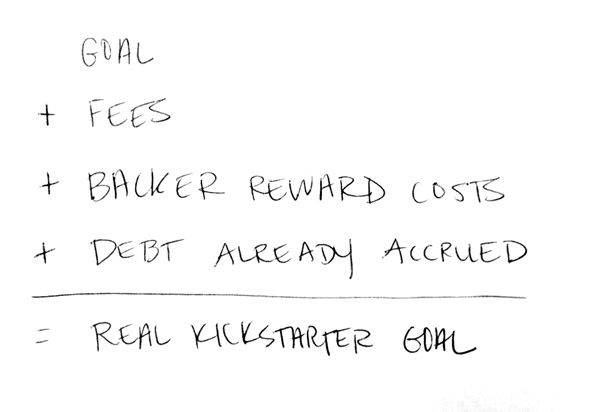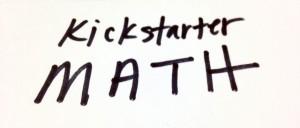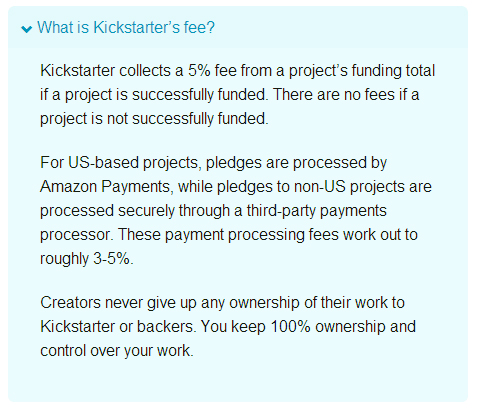Kickstarter has been on my mind for a long time. It was launched in 2009, about a year after I started my first feature-length film. Since then I’ve been watching, researching, participating, and observing so that I could one day run my own campaign. As that day draws near, I find myself thinking about Kickstarter math a lot.
There’s a lot to Kickstarter math. It can be tough to wrap your mind around it, especially if you are managing a LOT of details about the campaign. (Then again, maybe you’re a numbers geek, and this is all pretty straightforward to you.) Bottom line: there are a lot of campaign details to manage and a lot of them are about the math.
What a most people see is that big number in the upper right-hand corner of a Kickstarter page. That big, glowing number that means a project has been successfully funded? Yeah, that’s the one.
Take, for example, the Ned Rifle project. They raised $300k+ recently. That big, beautiful number sits up there like a champ, claiming to the world, “This project was a success!!!” Isn’t it awesome?
 But what most people can miss is the math behind that number. Because, well, Kickstarter is still pretty new. And — let’s face it — there are plenty of people who have heard of it, but haven’t dipped a toe in to confirm that the water’s fine. They think they know, but they haven’t quite tried it yet.
But what most people can miss is the math behind that number. Because, well, Kickstarter is still pretty new. And — let’s face it — there are plenty of people who have heard of it, but haven’t dipped a toe in to confirm that the water’s fine. They think they know, but they haven’t quite tried it yet.
That number looks mouth-watering from where I’m sitting (prepping to launch a campaign of my own), then I start to remember the math that goes with it. It gets overwhelming. Like, really overwhelming.
You see, there are plenty of costs associated with a project you might find on Kickstarter. There are fees, shipping, printing, production, and labor costs. So, obviously, not all of that incoming cash goes straight to the project.
In fact, roughly 10% of a successfully funded project’s income goes directly to Kickstarter and Amazon. Below is a screenshot from the Kickstarter website, which explains these fees.
After you subtract that 10% from your incoming cash, subtract more for the fulfillment of your backer rewards. You have to make sure you send the right reward to the right person — in a timely manner. The fulfillment of backer rewards requires quite a bit of cash.

The Veronica Mars t-shirt I got for being a backer.
For example, let’s look at t-shirts. They need a design, which means you should pay a graphic designer for the print-ready artwork. Then you have to order the t-shirts. What sizes, colors, and fabric options are you selecting? You also have to get them shipped to you, then take apart that big order. You need new shipping materials and postage. Plus, you need to keep track of what goes where and when.
That t-shirt just got more and more complicated, the longer I thought about it. I’m exhausted and we haven’t launched yet. Thankfully, there are crowdfunding reward fulfillment companies starting up — to help folks like me keep these very important details straight.
In addition to the fees and fulfillment costs, a hefty portion of your incoming cash may go out the door immediately. To have a strong Kickstarter video and project story, you need to show that you’ve already started your project. And that you’re likely to meet said goal even if you don’t raise funds via Kickstarter because you believe in it that strongly. (For example, I have already started this new documentary and I will finish it even if we don’t meet our fundraising goal on Kickstarter. I believe in it that much.)
What most people don’t realize is that typically means you’ve already invested a lot of money in the project. That means you may have acquired some debt. Or you may have agreed to deferred payments for services, and you’ll have to make those payments soon. Especially if they see that you’re getting a fad stack of cash from your Kickstarter campaign. So you’re probably going to have to push a hefty chunk of change towards whatever debts you may have already accrued.
That brings me to another point. If you’re hoping to use this incoming cash to finish your project, you better make sure you’re actually going to have some incoming cash. That makes sense, right?
So this is where I am at this point. Take the number that you need and start adding to it. Add 10% for the fees. Add a certain amount for backer rewards. Add in the debt you’ve already accrued. And then you get a number for your Kickstarter goal.

This is where I’ve landed. But that might change after we launch / complete the campaign next year. What do you think?
Just be reasonable with your numbers. Think about what you actually need to make your film. Not the number you want. Not all of us are likely to successfully reach a seven-figure goal.
More on this later. My poor, creative mind is aching now. I’m going to go find a cold beer.


Camden — thanks for that breakdown. We haven’t started on our project yet but those numbers will be important when we do. Good Luck!
Let me know how it goes! Can’t wait to hear more!